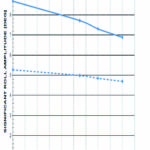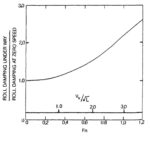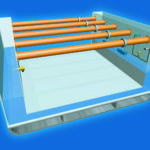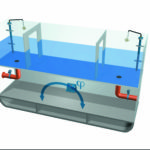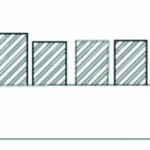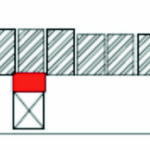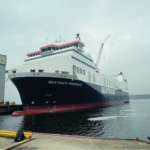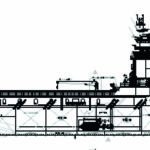Slow steaming is reducing bunker costs, but with slower speed also larger roll angles occur. Stabilization systems minimize roll amplitudes and thus avoid exceeding lashing forces. By Stefan Winkler and Michael vom Baur
With the explosion of fuel costs new strategies have been implemented by most container lines. While slow steaming (with speeds[ds_preview] around 14 to 15 kn) has been the first reaction on the increasing dominance of bunker costs since many months, many operators actually investigate plans to sail even slower (»ultra slow steaming« with 11 to 12 kn) while trying to use the maximum cargo capacity of the ships. With the slower speed not only the necessary number of ships increases, the individual ship operates also under different conditions, in respect of main engine load and seakeeping, which have to be taken into account for the planning of the service.
It is a known but often ignored effect that with slower speed larger roll angles occur. Fig. 1 shows the effect of the speed on roll damping properties with bilge keels but no other means of stabilization. A study done by Flume Stabilization (a company of Hoppe Marine) for a typical 8,400 TEU container vessel, sailing in irregular beam seas of 8 m significant wave height with a metacentric height (GM) of 4.0 m, indicates that the roll angle at 11 kn would be more than 11 % larger than at a speed of 18 kn and around 15 % larger compared to 20 kn. On the other hand, the roll angle is an important parameter in the computation of the accelerations and lashing forces. It is in fact the only parameter, which could be influenced (by a stabilization device) for a given ship geometry and load case (GM). For the above-mentioned ship and sailing condition a properly designed and tuned Flume Stabilization System would reduce the roll amplitude by 35 % (Fig. 2).
In order to estimate the influence of the amplitude reduction on the permissible average weight of containers stowed above the hatch the study has calculated the accelerations for the same 8,400 TEU vessel, GM and sailing conditions at a speed of 18 kn, with the simplified formulas provided in
the ABS guide for certification of container securing systems. It turned out that an assumed 30 % reduction of the roll angle, as it could definitely be achieved by a Flume anti-rolling tank, would reduce the transverse accelerations by around 30 % in the first to fourth tier. According to the ABS guide the permissible average weight on deck could thus be considerably higher, by more than 3 t. Of course such higher deck container weight could not be realized for all containership designs in the same way. Heavier deck containers would constitute a new load case and would thus be limited by the minimum GM requirements and load line as well as permissible stack loads on the hatches. However, the study clearly demonstrates the significant positive influence of reduced roll amplitudes on the lashing forces and the potential for economy and safety which could more than compensate implicated »penalties« of the slow steaming strategy. Last but not least the application of a Flume Stabilization System reduces the threat of parametric roll to almost zero.
Passive roll damping systems are offered in two main forms. For vessels with a relatively clear defined typical load case and where large holds and / or requirements of continuous fore-aft passage exist, an U-shaped tank such as Hoppe Marine’s U-tank Stabilization System would be appropriate (Fig. 3).
Such U-tank could also be combined with a blower-type anti-heeling system for the loading and unloading phase. If almost the full beam could be used for the anti-rolling tank and a broader range of load cases with sufficient GM reserve are to be expected (as on containerships), the free surface type known as Flume Stabilization System is a very cost effective and flexible tool (Fig. 4). Hoppe Marine, who has acquired the US company Flume Stabilization Systems in 2010, has carried out several installation pre-studies for different containership types. Figures 5 a, b and c show some possible locations for the integration of a anti-rolling tank on typical containerships. If considered during the ship design, the tank can mostly be allocated TEU neutral; in case of later retrofit a loss of up to 60 TEU slots may have to be accepted.
If the GM is predicted sufficiently high, the anti-rolling tank should be applied above the roll centre in order to use its full potential. The effect of its relatively high centre of gravity as well as the free surface is usually below 0,5 m GM reduction, which is even slightly smoothening the tough roll characteristics of modern wide beam container vessels in partial load condition.
Flume tanks must be carefully adapted and tailored to the individual ship design, for which Hoppe Marine / Flume can rely on a database full of decades of experience as well as own model testing facilities. Special internals define the damping characteristics. The tank can be either integrated into a newbuilding’s steel structure or may be retrofitted, it will be tuned to the actual load case by the filling level according to Flume’s instruction (Fig. 6).
Flume Stabilizers are well suited for container vessels, but also for a wide range of other ship types, e. g. RoRo ferries such as the recent »Seatruck« design of Flensburger Schiffbau-Gesellschaft (Fig. 7), offshore supply vessels (Fig. 8) and more.
Considering the studies described above, which will be extended in cooperation with major container vessel operators and classification societies, a stabilization system can become a key device to enhance economy and safety of container vessels.
Authors:
Dipl.-Ing. Stefan Winkler Project Manager Hoppe Marine, Flume Stabilizer
s.winkler@flume-art.com
Dipl.-Ing. Michael vom Baur MvB euroconsult
michael.vombaur@mvb-euroconsult.eu
Stefan Winkler, Michael vom Baur






